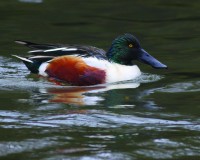Four Colly Birds, Three French Hens and Other Christmas Legends
 Let’s be honest. I always thought “The Twelve Days of Christmas” was kind of an annoying song. It goes on forever, it’s repetitive, and there’s not a lot of tonal variety. And there’s usually some windbag who hogs the “Five Golden Rings” line. You know what I’m saying?
Let’s be honest. I always thought “The Twelve Days of Christmas” was kind of an annoying song. It goes on forever, it’s repetitive, and there’s not a lot of tonal variety. And there’s usually some windbag who hogs the “Five Golden Rings” line. You know what I’m saying?
But now, as a full-fledged member of the Audubon Society, I look at ‘The Twelve Days’ in a different light; it’s a song with birds as its centerpiece. There are geese-a-laying, swans-a-swimming, French hens and calling birds all over the place. (An historic sidebar: Americans adapted “calling birds” from “colly birds,” which is British slang for blackbirds and pronounced “collie.”) And, of course, the countdown ends with a pair of turtledoves and the ubiquitous partridge perched in his pear tree.
Thus, half the lines in ‘The Twelve Days’ deal with birds. So you have to think, this person who is going to gather up a total of 23 birds of different sizes and habitats is a pretty ambitious and energetic fellow or lass. Are the birds live or dead? Have you ever tried to catch a swan or a goose? At least in the original French version, the birds are of smaller variety: pigeons, ducks and cockerels, in addition to the famed partridge.
Counting birds at Christmastime has taken on a different meaning for the Audubon Society for the past 112 years. In 1900, the just-hatched organization decided on an alternative to the “Side Hunt” kill-and-cull contests that were going on in America at the time, basically people going on a 24-hour shooting spree, piling up all the birds and other animals in the yard and tallying them up to see if they had a bigger pile of carcasses than their neighbors.
The first Christmas Bird Count comprised 25 reports, most of which were from the northeastern United States and Canada. Recently, the number of circles has grown to 20,000 and the number of participants to nearly 60,000. The data they gather in a three-week period between mid-December to the first week of the new year is instrumental in identifying population patterns and species that may be in decline or sometimes in growth. In 2007, Audubon Society published “Common Birds in Decline,” which showed how drastically the number of many well-known species had dropped in just 40 years. Some had dropped by as much as 80 percent due to urban sprawl, global warming, farming techniques and other factors.
Level of birding experience doesn’t matter when it comes to the Christmas Bird Count. Each circle is led by an experienced birder who compiles the data at day’s end. It’s a fun day out, which for birders involved in the Peekskill count, ends with a nice dinner and warm fire while the final tallies are being made.
The Christmas Bird Count is the ultimate expression of “think globally, act locally.” The numbers we help compile go into a national database and tell us about the overall health of our avian species and their habitats. It’s the world’s longest-running and largest citizen science project, and all you need to participate is some warm clothes and a bit of moxie to shake off the winter weather.
113th Annual Christmas Bird Count
Bronx-Westchester Count, Dec. 23. Putnam County Count, Dec. 29. Counts are held from dawn to dusk.
Saw Mill River Audubon, www.sawmillriveraudubonsociety.org, 914-666-6503. Central Westchester Audubon Society, centralwestchesteraudubon.org, National Audubon Society, birds.audubon.org/christmas-bird-count.
For the Birds is a monthly column which highlights birding activity in Westchester County and the region. Brian Kluepfel is a member of the Saw Mill River Audubon board.
By Brian Kluepfel

Adam has worked in the local news industry for the past two decades in Westchester County and the broader Hudson Valley. Read more from Adam’s author bio here.
